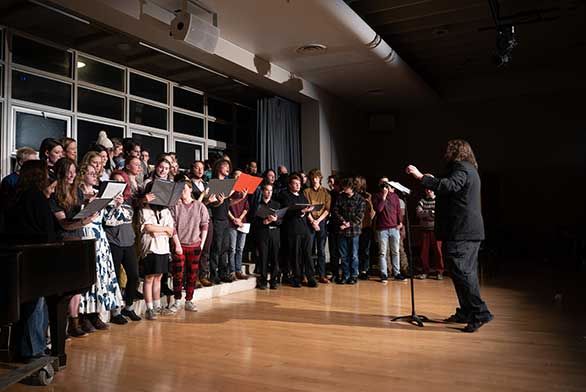Johnnies Don't Just Study Music—They Also Make It
November 12, 2024 | By Jennifer Levin
Plato saw music as being in dialogue with mathematics, and therefore as one of the organizing principles of the universe. On a less cosmic level, music is one of our first forms of creative expression. “Music is our birthright. I believe we’re all musicians,” says Andy Kingston, a St. John’s College Santa Fe tutor and jazz pianist. “Every society makes music together. It’s a fundamentally human experience, and if we’re going to take our education seriously, we have to ask what it means to be human.”

The quadrivium of music, arithmetic, geometry, and astronomy join the trivium of grammar, rhetoric, and logic to form the liberal arts paradigm that’s the basis for the St. John’s Program. “Geometry is shape, astronomy is shapes in motion, arithmetic is numbers—although it means multitudes—and music is number and relation,” Kingston explains, snapping his fingers as he counts. “One-two-three, one-two-three. It’s a way of thinking about relationships. That this note,” he sings, and then sings in a higher frequency, “sounds like this note!”
But music wasn’t always a formal part of the New Program, which the college implemented in 1937. Prior to 1970, it was offered as an extracurricular. “Music was introduced in the spirit of Plato’s original trivium and quadrivium,” says Peter Pesic, a musician-in-residence, pianist, and tutor emeritus in Santa Fe who has written three books about the relationship between music, math, and science. “One of the motivations to include it was to try to reflect on the ways that music had a formative influence on liberal education, or education at all in the West.”
Some St. John’s tutors play musical instruments while others do not—but since faculty teach across the curriculum, many lead freshman and sophomore music tutorials without any formal training. Pesic, who joined the college in 1980 as an accomplished pianist, recalls one beloved colleague with no musical experience who was particularly enthusiastic about diving into a new area of study.
“Ralph Swentzell’s background was in psychology and computer science, and he loved the Program,” Pesic says. “The chance to learn music, for him, was precious, and he produced this tremendous variety of materials that set the music tutorial going in the way it has been for more than 40 years. His approach struck me as unusually compelling—that our music program is yet another dialogue between the ancients and the moderns.”
Typical of the St. John’s Program, the deep exploration of any discipline—including music—requires starting at the very beginning. “The question is always, ‘How did we get here?’” Kingston says. Students begin studying music by reading Plato and other ancient sources while also trying to sing Greek music and Gregorian chants. “We spend a long time trying to understand what Plato meant by ‘the music of the spheres’—music appropriate to the divine beings, to the stars, to God—and how it differs from the music of the passions, which he also knew well,” Pesic says.
Students move forward in history to works like Vincenzo Galilei’s Dialogue on Ancient and Modern Music (1581), in which Galileo Galilei’s father described the developments in music that led to the first operas—right before his son’s seminal work shaping the new physics. They progress on to operas like Monteverdi’s L’Orfeo, which, Pesic explains, “shows the complex power of music, which Orpheus uses to bring Eurydice back to life but whose effect on himself he cannot finally control.”
By the end of their sophomore year, students have experienced great choral works; they can decipher musical notation; and they have some working knowledge of the diatonic system, melody, counterpoint, harmony, and rhythm. In addition to having sung in a freshman choir, some students also try their own hand at making music, writing their own compositions to understand Mozart’s work or trying their hand at piano to complement their reading. “It’s not just about tonal analysis. It’s a practice as well, a human activity,” says Santa Fe tutor and violinist Chistine Chen.
Outside of class, Johnnies can expand their musical knowledge through extracurriculars like student performance groups, study groups (Kingston recently led one on the “blues idiom” in American culture), and electives, which at St. John’s are called “preceptorials.” They are also continuously exposed to a wide variety of music from around the world: Chen chairs the Music Performance Committee, which is responsible for bringing big-name performers to the Dean’s Lecture and Friday Night Concert Series in Santa Fe; the Annapolis campus has an analogous program headed by tutor Eric Stoltzfus.
“Sometimes the concerts complement the Program and sometimes they go far afield from what we’re looking at in the classroom,” Chen says. “We’ve brought in madrigal singers and groups with Renaissance and baroque repertoires. More recently, we’ve had some really great artists who don’t always perform a standard Western repertoire.” Meanwhile, tutors like Pesic, Chen, and pianist and tutor emeritus David Bolotin are also known to perform on campus in Santa Fe.
Woven through their daily lives, music is a cornerstone of the St. John’s experience, broadening Johnnies’ perspectives of the world and their place in it. “The world thinks of music as a fine art,” Kingston says, “and we teach it as a liberal art,”

